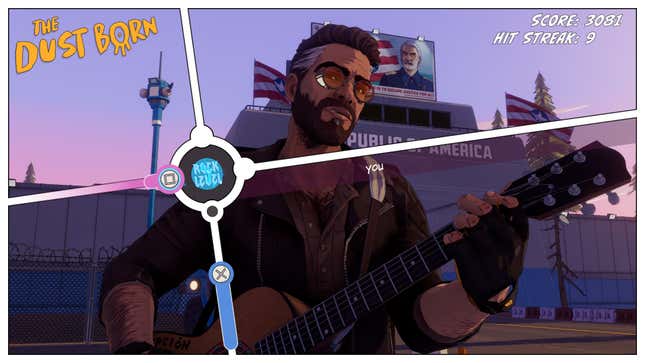In its first few hours, Red Thread Games’ Dustborn flaunts so many of the qualities I look for in a story-driven adventure game. It’s full of relationship-building with complex characters, has stakes that are just high enough to draw me into the weight of each dialogue choice I make, and its supernatural elements don’t feel so overbearing that they detract from the humanity at its center. I’m hooked. I want to learn more about protagonist Pax and her group of nomadic, superpowered roadtrippers. But, my god, I haven’t hit a momentum killer like Dustborn’s action combat in a game I’m otherwise enthralled by in a hot minute.
Dustborn follows a group of four smugglers, three of whom are “Anomals,” which are essentially X-Men mutants dealing with similar types of persecution. Pax can use her words to impose emotions, feelings, or actions on others. Her ex Noam can cancel out emotions entirely, which is good for diffusing a hostile situation or calming someone down from an anxiety attack. Using these powers in secret is one of the core tensions of Dustborn, as it both can expose the group to authorities who would gun them down if they knew they were Anomals, and because using Pax’s abilities can establish toxic, controlling dynamics between the cast. It makes every dialogue option feel weighty as you try to finish your country-wide smuggling job inconspicuously.
From the outset, Dustborn makes it clear that your relationships with your posse will take you down different ending paths, and I’m already finding myself wincing when I feel like my relationships with characters like Pax’s best friend Sai are on the rocks. Was I too hasty in using my powers to try and immediately fix a tense situation? Did I offer a gift at an insensitive time as I was figuring out how the dialogue mechanics work? We’re criminals with law enforcement at our front door. I thought I was being efficient, but now I see I was also being shortsighted. Hopefully, I’ll have time to make up for those mistakes as the game goes on, but Dustborn is effective at creating intense moments that test your patience and understanding of who you’re working with. There’s lingering baggage with each character from the outset, such as the unresolved relationship between Pax and Naom, or the lack of established trust between the group and their boss, the enigmatic absolute daddy Theo. Dustborn is already laying down multiple paths these relationships might follow, and I’m already drawn in by the possibilities.

But talking to your teammates is only half the battle, as you’re all undercover as a punk band. Dustborn throws in rhythm minigames as you carry on the facade. The music hasn’t made a huge impression on me yet, but there are more performances to come. The rhythm minigames themselves have been hit or miss, as rules about what the buttons I’m pressing correlate to in the music have sometimes made it difficult to actually get in the groove. Sometimes it feels like the required inputs are in time with the strums of a guitar, other times they correspond to vocals. The rules seem to change between songs, so I wonder what I’m supposed to actually be listening for as I anticipate every button press in-time with the prompts on screen. But while I expect I’ll get the rhythm down soon enough, I’m already dreading the next time I put down the guitar and pick up a bat to play Dustborn’s combat again.
Maybe I was spoiled growing up on character action games like the Devil May Cry series, but I have always felt like my standards for that genre have been pretty high. Even fairly competent action games like Nier don’t scratch the itch for me because they lack interesting enemy design that tests my skills and reflexes. Dustborn, meanwhile, makes such a flimsy attempt to emulate those games that its action is becoming an active roadblock to my enjoyment of the game. Pax gets a bat that she swings with imprecision, and it sometimes feels more like a half-hearted, shallow attempt at a beat-em-up than something with any depth. There are a few gimmicks that shake things up, like Pax using her powers to push enemies away or performing a quick rhythm interlude to deal greater damage to a single target. But overall, Dustborn’s attempt to add an action-oriented pillar to its gameplay loop feels ill-advised and overambitious. It’s always better to do fewer things well than it is to try and do too much.

Luckily, after the second combat encounter I was given an option to deemphasize combat for the rest of the game’s run. This is ostensibly to make the game easier for those who are just invested in the story, but Dustborn’s bat-swinging beatdowns weren’t even a challenge. They were just a trivial roadblock in the way of the things Red Thread Games does exceptionally well. President Theodore Roosevelt once said that one should “speak softly and carry a big stick,” but Dustborn doesn’t need a big stick to make an impact when the power of its words far outweighs the alternative. I’m hopeful I won’t have to pick up Pax’s bat that often as I continue her road trip, because all it’s done so far is make me want to turn this tour bus around.


